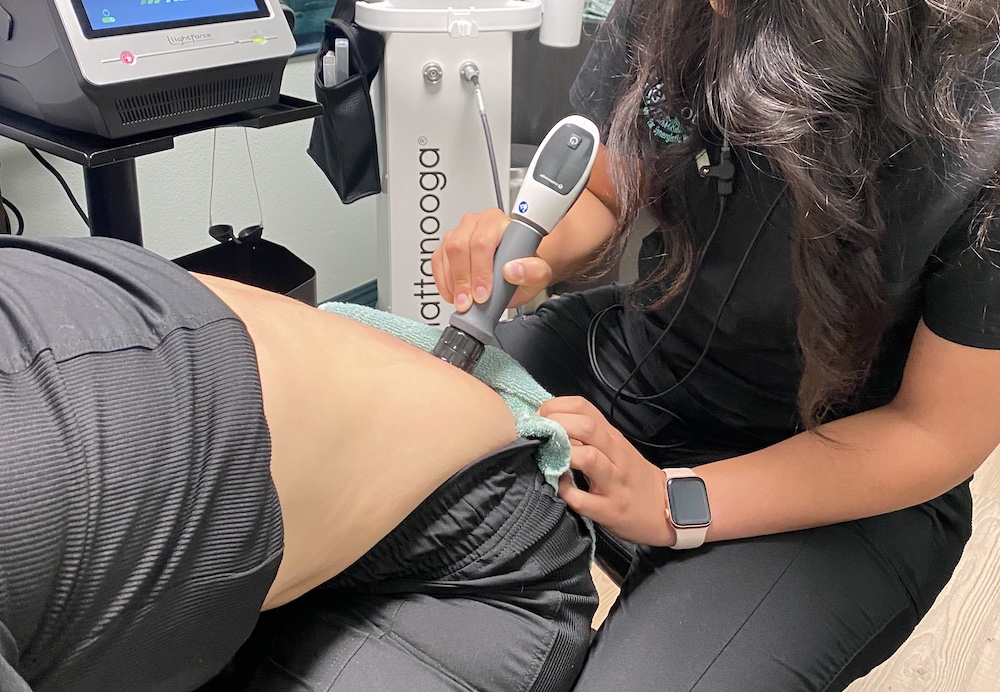As a local chiropractor, I understand how debilitating neck pain can be and how it can hinder your everyday activities. It's vital to find effective relief, and I want to share several natural techniques that can help you alleviate discomfort and support your healing process.
From gentle stretches to professional chiropractic adjustments, each approach brings its own set of benefits tailored to your needs. It's natural to wonder which strategies will be most effective for your individual situation. Let's delve into these options together and uncover the best techniques for achieving lasting relief from neck injuries. My goal is to empower you with knowledge about chiropractic care and natural healing, so you can make informed decisions about your health.
Gentle Neck Stretches
As a local chiropractor, I often see patients who experience tension and discomfort in their necks. Gentle neck stretches can be a wonderful way to alleviate this tension and enhance your overall well-being. You don't have to be a yoga professional; even simple movements can significantly improve your neck's flexibility and comfort.
To begin, find a comfortable position, either seated in a chair or sitting on the floor. Gently tilt your right ear toward your right shoulder, allowing you to feel a stretch along the left side of your neck. Hold this position for about 15-30 seconds while taking deep breaths. Afterward, switch to the left side to stretch the right side of your neck. These basic stretches can effectively release built-up tension in your muscles.
Next, I recommend trying a chin tuck. Sit up straight and slowly draw your chin toward your chest, as if you're attempting to create a double chin. This exercise not only stretches the back of your neck but also strengthens the surrounding muscles. Hold the tuck for about 5 seconds before returning to your original position. Repeat this several times for optimal benefits.
Another beneficial stretch is neck rotation. Gently turn your head to the right as far as feels comfortable, and hold this position for 15-30 seconds. Remember to switch sides afterward. This stretch is excellent for enhancing flexibility and reducing stiffness in the neck.
Integrating these gentle neck stretches into your daily routine can be a key part of maintaining a healthier neck and reducing discomfort. It's essential to listen to your body; if something feels too intense, ease back.
As your chiropractor, I encourage you to prioritize these natural healing practices as part of your self-care regimen. Your neck will thank you!
Heat Therapy
As a local chiropractor, I want to share some valuable insights about managing neck pain, particularly through the use of heat therapy. Many of my patients are often surprised to learn how effective heat can be in providing relief.
When you apply heat to the affected area, it promotes increased blood flow, which is essential for soothing sore muscles and alleviating stiffness.
Understanding the different types of heat sources available can empower you to take control of your healing process. Whether it's a warm compress, heating pad, or even a hot shower, each option can help ease your discomfort and enhance your recovery.
Let's delve into how you can effectively incorporate heat therapy into your routine for optimal neck pain relief.
Benefits of Heat Application
As a local chiropractor, I often see patients who are seeking relief from neck injuries, and one effective method I recommend is heat therapy.
Many individuals may not be familiar with how beneficial heat application can be for their recovery. Let me explain four key advantages of using heat for neck pain relief:
- Muscle Relaxation: When you apply heat to your neck, it increases blood flow to the area. This helps to loosen tight muscles and reduce stiffness, making it easier for you to move your neck without discomfort.
- Pain Relief: The warmth from heat therapy can help dull the pain receptors in your body. This means you may experience a significant decrease in discomfort, allowing you to engage in your daily activities with greater ease.
- Increased Flexibility: Heat therapy can also improve your range of motion. By softening the tissues in your neck, it becomes easier to perform everyday tasks without straining or feeling limited by pain.
- Stress Reduction: Lastly, the soothing effects of heat can promote relaxation. This not only helps to alleviate your neck pain but also reduces the stress and tension that may be contributing to your discomfort.
Incorporating heat therapy into your recovery plan can be a simple yet powerful way to support your healing process.
If you have any questions or would like to learn more about how chiropractic care can help you, feel free to reach out!
Types of Heat Sources
As a local chiropractor dedicated to promoting natural healing, I want to share some valuable insights about heat therapy for neck injuries. Understanding the various types of heat sources available can help you find the best option for your recovery.
One of the most common methods I recommend is the use of heating pads. These electric pads allow you to control the temperature, providing consistent heat directly to the affected area of your neck. This targeted warmth can help alleviate pain and relax tight muscles.
Another effective option is the classic hot water bottle. Simply fill one with warm water and place it on your neck for soothing relief.
If you're looking for a more natural approach, consider heat wraps made from materials like rice or flaxseed. These wraps can be heated in the microwave for just a few seconds and will mold to the contours of your neck, delivering focused heat where you need it most.
For a wonderfully relaxing experience, I often recommend a warm shower or bath. The combination of steam and warmth can work wonders for easing tension in your neck muscles and promoting overall relaxation.
Additionally, infrared heating lamps are an excellent alternative; they emit heat that penetrates deeper into your tissues, providing effective relief.
Regardless of which heat source you choose, it's essential to monitor the temperature to prevent burns and limit application time to about 15-20 minutes to ensure safety and effectiveness.
Cold Compress Application
As a local chiropractor, I want to share how applying a cold compress can offer immediate relief for neck injuries by reducing inflammation and numbing sharp pain.
If you're experiencing discomfort, using a cold compress is a straightforward yet effective method to alleviate your symptoms. Here's how to do it properly:
- Select the right material: You can use a commercial cold pack, a bag of frozen peas, or even ice wrapped in a cloth. It's important to choose something that can mold to the contours of your neck for optimal coverage.
- Prepare your skin: Always place a thin cloth or towel between the cold compress and your skin. This step is crucial to prevent frostbite and skin irritation while still allowing the cold to penetrate effectively.
- Apply the compress: Position the cold compress on the painful area of your neck. Keep it in place for about 15-20 minutes. This can be repeated several times a day, especially during the first 48 hours following your injury.
- Monitor your response: Be attentive to how your body responds. If you experience excessive discomfort or if the cold compress doesn't seem to provide relief, remove it immediately and consider consulting with a healthcare professional for further guidance.
Using a cold compress is a valuable tool for managing neck pain naturally.
By following these steps, you can ensure you're applying it correctly and making the most of its benefits.
Posture Correction Techniques
As your local chiropractor, I'm here to help you understand the importance of posture in relieving neck pain. One of the first steps to better neck health is to create an ergonomic workspace that supports your body in a natural position. This can significantly reduce strain on your neck.
In addition to adjusting your environment, I encourage you to incorporate specific stretching and strengthening exercises into your daily routine. These exercises can help improve flexibility and build strength in the muscles that support your neck.
Ergonomic Workspace Setup
As a local chiropractor dedicated to promoting your overall well-being, I want to emphasize the importance of creating an ergonomic workspace. Proper ergonomics is vital for maintaining good posture and minimizing the risk of neck injuries, which are common issues I encounter in practice.
By making a few thoughtful adjustments to your workspace, you can cultivate a comfortable environment that aligns with your body's natural mechanics. Here are four essential steps to consider:
- Chair Height: Start by adjusting your chair so that your feet rest flat on the floor and your knees form a 90-degree angle. This position alleviates unnecessary strain on your lower back and neck, helping to promote better spinal alignment.
- Monitor Position: Ensure your monitor is set at eye level and positioned about an arm's length away. This setup allows you to maintain a neutral head position, avoiding the common pitfalls of tilting your head up or down, which can lead to neck strain over time.
- Keyboard and Mouse Placement: Your keyboard and mouse should be close enough that your elbows remain at a 90-degree angle while you work. It's crucial that your wrists stay straight to prevent tension buildup in your neck and shoulders, which can exacerbate discomfort and lead to long-term issues.
- Lighting: Lastly, pay attention to the lighting in your workspace. A well-lit environment minimizes glare on your screen, which can force you into awkward head positions as you strain to see. Proper lighting is essential for your visual comfort and overall posture.
By implementing these ergonomic practices, you can significantly enhance your workspace and support your health.
Stretching and Strengthening Exercises
As your local chiropractor, I want to share some valuable insights on how incorporating stretching and strengthening exercises into your daily routine can significantly improve your posture and help alleviate neck pain. Many people are unaware that simple movements can make a profound difference in their overall well-being.
To start, let's focus on neck stretches. A gentle neck stretch involves tilting your head to one side and holding that position for 15-30 seconds before switching to the other side. This straightforward exercise can relieve the built-up tension that often arises from poor alignment and daily stressors.
Next, we need to strengthen the muscles that support your neck and upper back. One effective exercise is the chin tuck. By gently pulling your chin back toward your throat and holding it for a few seconds, you help align your head over your spine, which is crucial for maintaining good posture.
Another great exercise to try is wall angels. Stand against a wall with your arms raised and slowly slide them up and down while keeping your back flat against the wall. This not only strengthens your muscles but also promotes proper alignment.
Don't forget about shoulder shrugs! Simply lift your shoulders towards your ears and then relax them down. This exercise can help ease tightness in the shoulder area, which is often a contributing factor to neck discomfort.
To see real benefits, aim to incorporate these exercises into your daily routine for just a few minutes each day.
Massage Therapy
As a local chiropractor, I want to share how massage therapy can play a vital role in your recovery from neck injuries. This natural healing approach focuses on relieving muscle tension and enhancing circulation, which can significantly aid your healing process. If you're experiencing discomfort, a qualified massage therapist can be an invaluable part of your care team, targeting specific areas to help release tightness and promote recovery.
Here are four essential benefits of incorporating massage therapy into your treatment for neck injuries:
- Reduced Muscle Tension: Massage therapy is effective in relaxing and elongating tight muscles, which can help alleviate pain and stiffness in your neck. This tension release is crucial for restoring balance and comfort.
- Improved Blood Flow: Enhanced circulation through massage facilitates the delivery of vital nutrients and the removal of waste products from injured tissues, supporting the healing process.
- Enhanced Range of Motion: Regular massage sessions can improve the flexibility of your neck, allowing for easier movement. This can help you perform daily activities with less discomfort and greater ease.
- Stress Relief: Managing a neck injury can be a source of stress. Massage therapy not only addresses physical pain but also helps to reduce mental stress, fostering a greater sense of well-being.
When considering massage therapy, it's essential to have open communication with your therapist about your specific symptoms and pain levels. This ensures that they can tailor their techniques—whether it's deep tissue, trigger point therapy, or gentle Swedish massage—to best suit your individual needs.
Consistency is vital; regular massage sessions can lead to lasting relief and improved overall neck health.
As part of your neck injury recovery plan, I encourage you to explore the benefits of massage therapy. This holistic approach, along with chiropractic care, can help you achieve optimal healing and get back to enjoying life without discomfort.
Strengthening Exercises
As a local chiropractor, I want to emphasize the importance of strengthening exercises in your recovery from a neck injury. These exercises are crucial not just for restoring stability but also for preventing any future neck issues. By focusing on strengthening the neck muscles, you can also enhance your overall posture, which plays a significant role in reducing strain on your neck.
Let's start with some isometric exercises. These involve pressing your head against your hands or a wall while keeping your neck still. This approach activates your neck muscles without putting them under too much strain, making it an excellent starting point. I recommend aiming for 10 to 15 repetitions for each movement, focusing on your control throughout.
Next, we can incorporate lateral neck movements. This involves gently tilting your head to one side, bringing your ear toward your shoulder, and then returning to the center before switching sides. This exercise effectively strengthens the muscles on both sides of your neck. For those looking for a bit more challenge, using light resistance bands can be beneficial. Simply hold the band in one hand while you perform these movements.
It's also essential to include shoulder exercises in your routine, such as shrugs and rolls. Remember, your neck and shoulders work together, and strengthening your upper back can help alleviate pressure on your neck. Consider adding exercises like seated rows or scapular squeezes to your regimen.
Always listen to your body. If you experience any pain, stop the exercise immediately. Gradually increase the intensity of your workouts, and if you have any uncertainties about your routine, don't hesitate to consult with me or another healthcare professional.
Strengthening your neck muscles isn't just about recovery; it's a vital step towards promoting your long-term wellness. Together, we can work on a tailored program that suits your needs and supports your journey to better health.
Professional Treatment Options
As a local chiropractor, I want to help you understand the path to recovery from a neck injury and how natural healing can play a vital role in your treatment. It's important to recognize that recovery often involves various professional treatments tailored to meet your individual needs.
Here's how chiropractic care and other approaches can assist in your healing journey:
- Chiropractic Care: At our clinic, we specialize in spinal alignment, which is crucial for alleviating pressure on your neck. Through gentle adjustments and various techniques, we aim to promote healing, enhance mobility, and reduce discomfort. Our goal is to help your body function optimally.
- Physical Therapy: While we focus on spinal health, we often collaborate with physical therapists who can create a customized rehabilitation program. This program includes exercises to strengthen your neck muscles, improve flexibility, and alleviate pain, complementing the chiropractic adjustments you receive.
- Medication: Although our approach emphasizes natural healing, we understand that some patients may need additional support. Over-the-counter pain relievers, like ibuprofen or acetaminophen, can be useful for managing discomfort. For severe pain, we may work with your primary care physician to explore stronger medications or muscle relaxants if necessary.
- Injections: In certain cases, if conservative treatments aren't providing adequate relief, we may recommend consulting a specialist for corticosteroid injections. These can help reduce inflammation around affected nerves and are particularly beneficial for chronic pain.
Each of these treatment options can contribute significantly to your recovery. By actively participating in your care and working closely with our healthcare team, you can find the right combination of therapies that suit your needs.
Remember, healing takes time, but with the right support and a focus on natural healing, you can return to your daily activities with renewed strength and function.
Let's guide you on this journey to wellness!
Conclusion
As your local chiropractor, I want to share with you some effective techniques that can significantly aid in relieving neck injuries. By incorporating these seven strategies into your daily routine, you can promote healing and enhance your overall well-being.
First and foremost, gentle stretching is essential. It helps maintain flexibility and reduces tension in the neck muscles. Additionally, alternating heat and cold therapy can provide immediate relief – heat soothes tight muscles, while cold can help reduce inflammation.
Another crucial aspect is maintaining good posture throughout your day. Proper alignment can alleviate pain and prevent further strain on your neck. Alongside this, strengthening exercises are vital; they not only support recovery but also help prevent future injuries.
Don't overlook the benefits of massage therapy, which can complement your treatment and enhance relaxation. If you're seeking more personalized care, professional chiropractic treatments can provide tailored support that addresses your specific needs.
I encourage you to take a proactive approach to your neck health. By integrating these techniques, you're setting yourself on a path to a healthier, pain-free neck. Remember, I'm here to guide you every step of the way!



